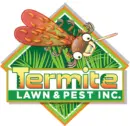Name: 𝘚𝘱𝘩𝘦𝘤𝘪𝘶𝘴 𝘴𝘱𝘦𝘤𝘪𝘰𝘴𝘶𝘴
Size: ~15 to 50 mm
Characteristics: Among the largest wasps in Florida. Robust build. Reddish, black, and yellow body. Light yellow stripes on rear segment. Coloration superficially resembles that of yellowjacket and hornet. Female is typically larger than male.
Locations: Commonly found in residential neighborhoods: yards, gardens, and parks. Inhabits open areas with sparse vegetation, such as grass-covered banks, berms, hills, and fields. Often nests near raised sidewalks, driveways, patio slabs, and other structures with gaps or loose soil where it can dig burrows.
Mud Dauber
Name: 𝘚𝘤𝘦𝘭𝘪𝘱𝘩𝘳𝘰𝘯 𝘤𝘢𝘦𝘮𝘦𝘯𝘵𝘢𝘳𝘪𝘶𝘮
Size: ~24 to 28 mm
Characteristics: Elongated abdomen. Black narrow waist. Various yellow markings on thorax. Black eyes. Black antennae. Black and yellow legs. Tawny-colored wings.
Locations: Often builds nests in and around man-made structures: barns. garages, sheds, porches, under housing eaves. Requires mud to construct its nests. Commonly found near water sources: puddles, pool edges, streams, wet soil areas.
Paper Wasp
Name: 𝘗𝘰𝘭𝘪𝘴𝘵𝘪𝘯𝘢𝘦
Size: ~13 to 25 mm
Characteristics: Slender body with narrow waist that separates abdomen from the thorax. Varies in coloration: shades of brown, black, and yellow, often with distinct patterns. Relatively small compared to other wasp species. Has two pairs of membranous wings, typically longer than its body. Clear wings with visible veins. Long, thin antennae. Stinger at end of body.
Locations: Often attracted to gardens and parks due to the abundance of flowers (nectar). Frequently builds nests around homes, barns, sheds, and buildings (under eaves, in roof overhangs, on window sills). Wooded areas provides ample resources to build nests with dead wood and plant stems. Can thrive in urban environments. May establish nests in urban parks and along city streets.
Velvet Ant (Cow Killer Ant)
Name: 𝘚𝘤𝘦𝘭𝘪𝘱𝘩𝘳𝘰𝘯 𝘤𝘢𝘦𝘮𝘦𝘯𝘵𝘢𝘳𝘪𝘶𝘮
Size: ~6 to 20 mm
Characteristics: Commonly referred to as an ant, but is actually a wasp. “Cow killer ant” name is derived from the myth/misconception that its sting is potent enough to kill a cow. However, this is an exaggeration and not accurate.
Gets velvety appearance from coarse setae covering most of its body. Striking red or orange color with black or white markings. Elongated and segmented body with distinctive parts: head, thorax, and abdomen. Female lacks wings. Male has more prominent eyes.
Locations: Grasslands, meadows, deserts, forests, and scrublands. Can be found in parks, nature reserves, and other protected areas. May venture into residential areas with gardens and flowering plants in search of nectar or prey.
.
Termite Lawn and Pest, Inc
4524 Parkway Commerce Blvd
Orlando, Florida 32808
Phone: (407) 447-7378
